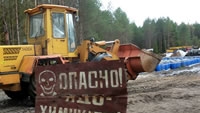For good reason: about thousand people living closest to the burial site mostly drink well water and good ground water is crucial for them. Analysis showed a small amount of pesticides had leached from the burial site to underground waters. And there was a significant risk that more pesticides could pollute the groundwater, affecting well water as well as rivers.
Oleg Lis, Head, of the Slonim Department for Inspection of Natural Resources and Environmental Protection says: "The landfill is a short distance of about 7 km away from our main water artery, the River Schara."
Not only do Slonim's 50,000 inhabitants rely on the Shchara; one of its main tributaries is only 2.5 km from the burial site and was potentially threatened by the dangerous chemicals, too.
After four decades under ground, there was no guarantee that hazardous pesticides were still entirely contained. Pesticides in concentrations above permissible levels were detected in ground water samples as far away as 184m from the edges of the burial site.
Nina Homar, Bolsheshilovichi Village Executive Committee Administrator "At the time when the pesticides were buried, there must have been no information on their harmful impact, so people were not seriously concerned."
DDT has been proven toxic to humans in laboratory tests, and legislation prohibiting their use was adopted back in 1980s. But what to do with the existing stocks?
Country plans to clean of any obsolete pesticides by 2028
Belarus takes seriously its obligation under the Stockholm Convention on persistent organic pollutants to minimize any release of persistent organic pollutants (POPs) into the environment. Between 2004 and 2006, the Ministry of Natural Resources and Environmental Protection, in cooperation with the World Bank, created a national program to develop national hazardous waste management treatment and disposal capacity.
In 2009, Belarus accessed international financing to solve its pesticide problem and to destroy 1,800 tons of POPs stockpiles and waste, and to develop a long-term plan for POPs elimination in accordance with convention requirements.
A massive cleanup operation at the Slonim burial site started in 2011. It was important to devise special methods, use special protective gear and tools, so as not to pollute the environment or cause risk to the people, so the Special Operations Unit of the Ministry of Emergency Situations was contracted to do the work.
Yuri Soloviev, Ministry of Natural Resources and Environmental Protection, Project Manager: "As of today, 950 tons of obsolete pesticides have been excavated, packed properly in barrels and shipped to Germany for disposal at a specialized facility. Another 750 tons were extracted, repackaged and transferred to secure storage, and will be destroyed in an environmentally sound manner by May 2013. In a year's time, we intend to plant trees here, which 20 years from now will grow into a good forest."
After all these toxic chemicals are removed, local villages will walk in the forest freely and feel perfectly safe, says Pavel Shurko, Deputy Director of Slonim Agroservice. And they will no longer be afraid to drink the water.

